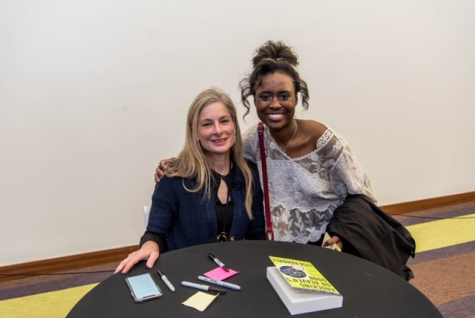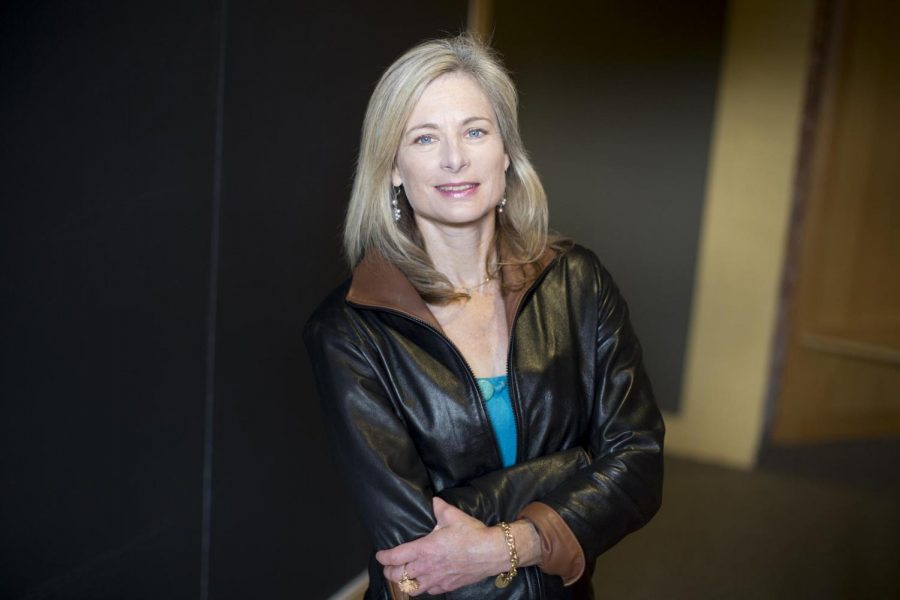How many ‘Hidden Figures’ does it take to make a ‘Theory of Everything?’: (Harvard physicist Lisa Randall says biases are holding back discovery)
One of the most influential physicists of our time, Lisa Randall’s research has helped shed light on dark matter, supersymmetry and expanding our knowledge of the Standard Model of physics. Her new theoretical work proposes multiple “brane” dimensions to account for the “fine-tuning” needed to harmonize quantum mechanics and the Standard Model
April 9, 2020
When the fourth subsequent question from the audience was asked by another male, theoretical physicist Lisa Randall leaned into the microphone and paused. She then called on girls in the audience to not be afraid to come forward and speak.
Randall, a leading figure in both particle physics and cosmology, gave a presentation in an event hosted by the College of DuPage’s physics department on March 1 on how biases in perspective prevent us from asking the truly important questions regarding life and the universe.
Among her work on the universe’s most fascinating curiosities, like dark matter, Randall’s support for multi-dimensional “brane” universes (shaped like membranes) to explain the fascinating unexpected weakness of gravity in our universe (often sought as a “Theory of Everything” linking the calculations of quantum mechanics and classical physics) has helped turn her into an icon for women and men alike.

Randall was introduced by Cierra Desmaratti, president of COD’s Society of Women Engineers (SWE) and an aspiring bioengineering student.
“Randall is a pioneer for all women in the physics and science fields,” Desmaratti told the audience. “She was not only the first woman tenured at Princeton University but also became the first female theoretical physicist to be tenured at Harvard University. Her passion for bringing physics and her research to the general public has brought her before us today.”
After Randall’s lecture, Desmaratti discussed with me the importance of confronting gender and racial biases and stereotypes in promoting greater diversity in STEM fields.
Lisa Randall: Knocking on Heaven’s Door – “The worst excuse for missing out on discoveries is we just didn’t think to look”
Gravity holds everything together, but when it comes to physics, its unexpected weakness makes the mathematics fall apart.
Of the universe’s four fundamental forces (gravity, electromagnetism, the strong force and the weak force), gravity, against all calculated predictions, is perplexingly the weakest. Unlocking gravity’s secrets could lie key to discovering the coveted “Theory of Everything,” helping us completely grasp the forces governing the cosmos.
“You wouldn’t think so, but particle physicists actually get very excited when things don’t match our predictions. It means there’s something beyond our models,” Randall told the audience. “We are often looking for tiny inconsistencies that can reveal much larger truths. The standard model describing elements and their interactions leaves so many questions unanswered.
“We think we understand the world around us, but when we look really closely, we find things are very different than expected,” she continued. “What we see is very limited, and there’s a big difference between what isn’t there and what we just haven’t observed yet. The worst excuse for missing out on discoveries is we just didn’t think to look.”
Randall said biases in our perspectives prevent us from not only objectively appreciating the dynamics of life around us but also in formulating questions that could illuminate the mysterious wonders of existence. She said we come across truths every day but overlook their importance because our biased perspectives prevent the imagination and creativity necessary to fuel innovative discovery.
The very nature of life and the universe changes depending on the scale and perspective we choose to observe it in.
Randall compared appreciating different scale magnitudes to understanding Earth’s placement among the eight planets in our solar system. Then, understanding our sun is one of only 200 billion estimated in the Milky Way Galaxy, and the Milky Way as only one of the estimated 100 billion galaxies in our expanding universe.
She then spoke of the scientific importance in learning to appreciate minute scales in understanding the anatomy of our own bodies. The body contains around 37.2 trillion cells. Within those cells, there are an estimated seven billion billion billion atoms. Within these atoms are nuclei consisting of protons, neutrons and electrons. Within protons are quarks and muons and neutrinos.
“The scale of 10 to the minus 17 is the frontier being examined at the Large Hadron Collider (to collide and examine protons),” said Randall. “That’s the lowest scale our technology allows us to examine, but at even smaller scales currently beyond our grasp, very different physics may emerge. This is where quantum mechanics and gravity might merge together.”
Randall said classical mechanics works well as an approximation of larger bodies in the universe but was inadequate to describe the structure of the atom. She compared today’s efforts of observing the universe through different wavelengths, such as x-rays or infrared, or even studying gravity waves or dark matter, to the original exploration to study the quirky subatomic world.
“Scientists found evidence things did not make sense when studying the atom and had no choice but to challenge their previous assumptions and go into quantum mechanics,” said Randall. “In the quantum world, there’s uncertainty; that challenged our idea that all things in the universe were probabilistic. It forever altered the way we see the world.”
Randall said the Large Hadron Collider represents today’s revolution, where physicists are trying to learn how particles acquire mass. If particles inherently had mass, all calculations with particle physics would lead to nonsensical predictions. She spoke of the excitement of discovering the Higgs boson (prematurely called the “God Particle”), however, its mass was far weaker than physicists expected.
“What explains the weakness of gravity?” Randall asked. “If gravity was comparable in strength, then the masses we are discovering wouldn’t be so small. To get the calculations of the standard model to work, it requires fine-tuning. The Large Hadron Collider still hasn’t found anything to explain the necessity for this fine-tuning.
“We are trying to study dark matter because it contains five times the energy of the universe’s ordinary matter. Because dark matter doesn’t interact with light, we study its gravitational influence. We are hoping to see some tiny interaction with the standard model at the LH Collider, but nothing’s happened yet.”
She said thinking creatively about one of our barriers in scientific knowledge helps lead us to bigger theoretical ideas. She said dark matter doesn’t experience our electromagnetism (why we can’t see it), but maybe it has its own undiscovered force that affects the structure of the universe.
Randall said we cannot be afraid to consider such ideas, or we could be missing out on the larger universal picture. She alluded to supersymmetry (requiring identical equations for force and matter, involving currently undiscovered “cousin” particles to all known particles) and string theory (which requires multiple dimensions for its calculations to hold).
“Most people assume there are three dimensions to space (four including spacetime). However, just like how the atom was hidden before its discovery, there could be hidden dimensions to space,” said Randall. “What I’ve worked on is the possibility of brane dimensions. If there are extra dimensions to space, perhaps not everything travels equally in those dimensions.”
“Maybe our entire world, our entire universe, is actually fixed in one position in the extra dimension. That could explain why we’re only cognizant of three dimensions; we’re only traveling around three dimensions. Forces would spread out as if there are only three dimensions. Electromagnetism would only spread out on the brane. What if gravity is connected to the geometry of not just one brane, but the entire spacetime? Gravity knows there are extra dimensions because it can travel through them.”
Randall proposed brane dimensions as the reason why the Higgs boson’s mass is so light and why gravity is so weak when it acts on standard model particles.
“We’ve been experimenting with the possibility of multiple branes, and calculated the strength of gravity decreases exponentially as you go from one brane to the other,” said Randall. “There’s just one gravity, but masses on our brane are exponentially smaller than expected.”
Randall said the LH Collider should be able to test for particles that travel in the extra dimensions. These particles won’t be stable, but we can measure their decay. She said nothing has been found yet, but that could just be because the collider lacks sufficient energy to produce the particles.
While fielding questions from the audience, Randall replied the complexity in the unknown is beautiful and what makes the challenge of being a scientist so exciting.
“I often look at newspapers and am horrified when scientific thinking is rejected in favor of what certain people prefer to be true,” Randal replied to a question about safeguarding science in today’s political climate. “Don’t vote for the current president. A big part of creativity involves awareness of different types of ideas and putting them together in new and interesting ways. New ideas are always built upon previous questions and theories. We have to understand what all the information we have actually means. You have to be willing to question your own ideas at every step. It’s vital we decide as individuals and a society, ‘What are the questions we are going to work together to solve?’”
Cierra Desmaratti: A place for Girls to Shine – “If you don’t fit the dominant stereotype, you’ll be less encouraged to enter STEM fields”
“Growing up, I didn’t have any female, black engineers I could look up to,” said Desmaratti. “I often felt like I had to lead myself. As a leader in her field, Randall is inspiring. It’s encouraging she asked the girls to step forward because it takes courage to confront the intimidation of STEM fields.”

While excitingly looking around the room at her new classmates in her first STEM classes, Desmaratti began to notice an unfortunate pattern.
“In my physics classes, I’m always outnumbered almost nine-to-one by guys,” said Desmaratti. “As a female, you are always second-guessing yourself and don’t feel comfortable asking questions. You fear any mistake will be used against you. We see men being confident, even in their failures. As a woman, especially as a minority, you have to prove yourself 10 times more to be taken seriously in STEM fields.”
“Men are taught to believe, ‘This is our world.’ It’s hard to express the stereotypes and hurdles we face to others who haven’t experienced them. We are just trying to find our place and survive in the field, and we are required to develop a thick skin to prevent the discriminations from holding us back.”
Curious for ways to provide greater demographic equality in STEM fields, Desmaratti researched and gave a presentation (“Enriching the STEM System”) to College of DuPage’s STEM faculty division at their meeting in January.
“My research indicated how phenotypes perceive your STEM capability, especially from academic advisers and teachers,” said Desmaratti. “When you break it down by race, the more Asian-American you look, the higher your intelligence is perceived. Your teachers and advisers will then push you toward STEM careers. If you don’t fit the dominant stereotype, you’re encouraged far less. For African-Americans, it’s the opposite. The blacker you are, the less you are to be perceived as intelligent. African-American females literally become ‘hidden figures’ within the education system.”
Desmaratti hoped her research would help inspire the college to promote and provide greater funding for the Society of Women Engineers club.
“I joined SWE because I wanted to find a stronger female environment that was missing from my classes,” said Desmaratti. “The classroom can be ostracizing and cause students to self-isolate. In talking with members of SWE, you realize how important women’s voices are. You shouldn’t fear having a strong voice or being opinionated and exuding power. These characteristics are often thought of as male characteristics. We are trying to change that.”
Desmaratti said the problems are starting to become recognized and, from companies investing in equality promotion to COD professors promoting SWE and making conscious improvements to their classroom environments, STEM fields will soon become a place for everyone to flourish.
“Without diversity in the field, we will always miss out on so many unique perspectives and innovations,” said Desmaratti. “STEM fields are a place for girls to shine because our empathy of social injustices help us value altruism and the importance of using science to make the world a better place. Someday, I hope to be a role model to young girls who were just like me, looking for an inspirational figure to show them their dreams are truly achievable and will one day help them change peoples’ lives.”
(For Related Articles)
(JOEY WESLO: Women physicists speak on challenging gender inequality in the field)
(JOEY WESLO: Physicist Brian Greene proposes string theory as the “Theory of Everything”)
————————————————————————————————————————-





















Elora Choudhury • Apr 11, 2020 at 3:12 pm
I was blessed to attend this event and meet these wonderful ladies. Their contributions to STEM are carving the path for future female scientists and people passionate about the field!